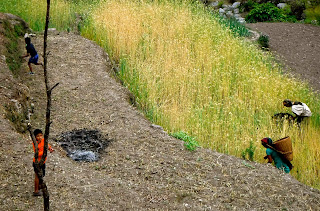I saw one tractor that worked and another buried in a ditch. The standard seems to be oxen pulling a one row wooden plow with a young man guiding it, and a woman walking behind, hand sowing. Folks seem to produce enough to support themselves, with plenty of goats and chickens running around for a little variety.
Wednesday, April 20, 2016
Day 20: Nepali Farming...Especially for my Iowa Farming Family :)
I was absolutely fascinated by the farming techniques and practices we walked right through on the Annapurna Trek. Vern felt it was like stepping back into the 15th century, except for the cell phone or brightly colored t-shirt you might see in the fields!? The climate is mild enough to farm year round and the most common rotation is rice for 6 months and wheat for 6 months. We also saw lots of corn, potatoes, cabbage, watermelon, cauliflower, carrots, turnips, lentils, peas, greens, buckwheat, and millet. Even an occasional tomato and orange tree! The way they grew peas with wheat, and how they stacked corn in circular fashion was so interesting. Superflour is now produced in Nepal and especially beneficial for malnourished children. It's made from one part soybeans or peas, one part maize or rice, and one part wheat, millet, or buckwheat. It is ground and roasted, then stirred into boiling water or baked into bread or biscuits.
I saw one tractor that worked and another buried in a ditch. The standard seems to be oxen pulling a one row wooden plow with a young man guiding it, and a woman walking behind, hand sowing. Folks seem to produce enough to support themselves, with plenty of goats and chickens running around for a little variety.
Two parts pulse – soybeans are best, but other small beans, grams and peas can also be used
One part whole grain cereal such as maize or rice
One part another whole grain cereal such as wheat, millet or
buckwheat. The pulses and grains need to be cleaned, roasted well
(separately) and ground into fine flour (separately or together). The
flour can then b
- See more at:
http://tilz.tearfund.org/en/resources/publications/footsteps/footsteps_51-60/footsteps_52/weaning_practices_in_nepal/#sthash.EPNDlWvf.dpuf
I saw one tractor that worked and another buried in a ditch. The standard seems to be oxen pulling a one row wooden plow with a young man guiding it, and a woman walking behind, hand sowing. Folks seem to produce enough to support themselves, with plenty of goats and chickens running around for a little variety.
Subscribe to:
Post Comments (Atom)







No comments:
Post a Comment